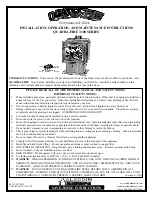
Page 4
OPERATING INSTRUCTIONS
A different type of heater.
The pellet stove is
neither a cord wood stove nor a furnace. Its
operation and maintenance differ from the tra-
ditional wood stove. FOLLOW THESE
OPERATING INSTRUCTIONS EXACTLY AS
STATED TO ENSURE SAFE AND RELIABLE
OPERATION.
1. Carefully read this “Operation and Mainte-
nance” manual in its entirety BEFORE lighting
your stove for the first time.
2. Obtain final inspection and approval of
installation from local building officials.
3. Carefully clean all marks off the gold plated
parts before the first fire is lighted. Use a soft
cloth and a “Windex” type cleaner.
Caution:
Never use an abrasive cleaner on any plated or
painted parts of the stove.
4. Have your dealer demonstrate all the opera-
tional and maintenance steps necessary for proper
use of the stove. Sign and return the warranty
card, to the address listed on the back page.
5. Some odors may be given off during the first
few hours of burning during initial break-in.
These odors are normal and not harmful.
However, ventilating the room until the odors
disappear is recommended.
6. The stove will become HOT while in
operation. Keep children, clothing and furniture
away from all stove surfaces.
WARNING: Direct
contact with the stove while operating may
cause skin burns.
7. To avoid the possibility of smoke and/or sparks
entering the room always keep firebox and de-
ashing doors closed whenever the stove is
operating.
8. A certain amount of carbon monoxide may be
produced within the stove as a by-product of
combustion. All exhaust vent connections must
be sealed with RTV silicone to assure a gas tight
seal. Any leaks into a confined area caused by
faulty installation or improper operation of the
stove could produce dizziness, nausea and in
extreme cases, death.
9. An outside source of combustion air is strongly
recommended and is required on all mobile home
installations. If room air is used to supply
combustion air, room air starvation, operation of
exhaust fans and icing of air vents can adversely
affect proper stove operation.
10. Smoke detectors, installed in the same general
area as the stove, may be activated if the stove door
is left open and smoke is allowed to enter the area.
Combustion Damper Adjustment
Your stove is equipped with an air inlet damper.
Before lighting your stove for the first time READ
the following and adjust this damper accordingly.
The purpose of this damper is to adjust combustion
airflow to match the characteristic of each specific
air inlet and chimney configuration. There is a
setscrew in the damper
(shown in Figure 1 on page
5)
and the damper has been preset at the factory.
This setting will most likely work for 90 % of the
most common installations. Long horizontal runs
might need the damper opened. Tall vertical runs
might need the damper to be closed a little, etc. To
adjust the damper, use the setscrew to make the
adjustments. To make an adjustment turn the screw
½ turn clockwise to open the damper or ½ turn
counter clockwise to close the damper. Remember to
use the damper handle to bring the damper up to the
screw. The damper will not close by itself. After
making an adjustment wait at least 15 minutes to see
how the burn pot reacts to the change.
Adjusting
the damper during the break in period is very
important (See “Preventing Chimney Fires” on
page 2)
. Break-in requires the burning of 15 bags of
pellets or continuous burn for two weeks. If during
the initial break-in period you experience difficulty
keeping the stove burning or there appears to be an
excessive amount of burning pellets being evacuated
from the burn grate, it may be necessary to close the
damper some more. Once the damper is fine tuned
for settings 1, 2, 3 and 4 the stove will run fine
without having to make a change to the damper
setting unless the stove is run on 5 or 6 for extended
periods of time. It is normal for ash and some sparks
to be continually evacuated from the burn grate. This
is how the grate continuously cleans itself. The
equivalent of a teacup of unburned pellets a day in
the ash pan is considered normal. Further adjustment
may be needed if you continue to have excess pellet
evacuation.



































